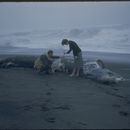Diagnostic Description
(
Anglèis
)
fornì da Fishbase
Distinguished from all other sharks by the enormous gill slits practically encircling the head; dermal denticle gill rakers; pointed snout; huge, sub terminal mouth with minute hooked teeth; caudal peduncle with strong lateral keels, and lunate caudal fin. Body covered with placoid scales. Blackish to grey-brown, grey, or blue-grey, often with irregular white blotches under the head and abdomen (Ref. 43278). Also Ref. 309, 5983.
- Recorder
- Crispina B. Binohlan
Diseases and Parasites
(
Anglèis
)
fornì da Fishbase
Dinematura Infestation. Parasitic infestations (protozoa, worms, etc.)
- Recorder
- Crispina B. Binohlan
Diseases and Parasites
(
Anglèis
)
fornì da Fishbase
Nemesis Infestation. Parasitic infestations (protozoa, worms, etc.)
- Recorder
- Crispina B. Binohlan
Life Cycle
(
Anglèis
)
fornì da Fishbase
Distinct pairing with embrace (Ref. 205). Courtship behaviour patterns associated with elasmobranch reproduction were documented from an aerial observation which include 'parallel swimming', 'pectoral biting', 'nudging', and 'male on top of female'. Other mating behaviours particular to this species from the same aerial observation include nose-to-tail following; flank approach; close approach involving rostral contact or proximity with the gill, pectoral fin, vent, and dorsum; and echelon swimming (Ref. 37026). Exhibit ovoviparity (aplacental viviparity), with embryos feeding on other ova produced by the mother (oophagy) after the yolk sac is absorbed (Ref. 50449). Estimated gestation period 12-36 months (Ref. 247, 1765, 9030, 88829); TL at birth estimated between 150-200 cm; mating thought to take place during early summer; a female giving birth to young captured in August in Norwegian waters (Ref. 5983). Over a study period of 5 years, courtship-like behaviour was observed off southwest England between May and July, always in surface waters along thermal fronts; because actual mating was not observed, this may occur in deeper water (Ref. 88831). A one-year resting period between pregnancies is thought to occur, resulting in a 2-4 year interval between litters (Ref. 9030, 1765, 88829). Only one pregnant female has been observed giving birth to a litter of 6 pups (Ref. 88830).
- Recorder
- Crispina B. Binohlan
Migration
(
Anglèis
)
fornì da Fishbase
Oceanodromous. Migrating within oceans typically between spawning and different feeding areas, as tunas do. Migrations should be cyclical and predictable and cover more than 100 km.
- Recorder
- Kent E. Carpenter
Morphology
(
Anglèis
)
fornì da Fishbase
Dorsal spines (total): 0; Dorsal soft rays (total): 0; Analspines: 0; Analsoft rays: 0
- Recorder
- Crispina B. Binohlan
Trophic Strategy
(
Anglèis
)
fornì da Fishbase
Selective filter feeder that orients itself towards the most productive zooplankton patches, preferring areas where zooplankton density is above 1 g/m3 (Ref. 88781). Occurrence and movements appear to be correlated to sea surface temperature, in particular to the thermal boundaries at tidal and shelf-break fronts (as these areas may have seasonally productive zooplankton patches which the shark locates and utilizes) (Ref. 50200, 88781, 88826). Often in close association with shoals of other fish such as Clupea harengus and Scomber scombrus in the Northern Atlantic (Ref. 310). During the summer months the basking shark is often seen swimming slowly near the surface with its large mouth held open for approximately 30 to 60 seconds. Water passively enters its mouth, possesses long bristly gill rakers on long gill arches to filter out the zooplankton. It periodically closes its mouth and forcefully constricts its gill arches, probably as a means to expel as much water from the buccal cavitiy (Ref. 33579). On average, about half a tonne of plankton may be found in an individualâs stomach (Ref. 43278). During the winter months found to inhabit the deeper waters of the shelf and shelf edges of the northeast Atlantic (Ref. 50200), the winter diving behaviour may be related to the search for discrete calanoid patches at deeper depths (Ref. 50200).
Biology
(
Anglèis
)
fornì da Fishbase
The second largest shark, reportedly reaching 1,220-1,520 cm TL (Ref. 247). Thought to live up to 50 years (Ref. 9030, 89083). Semi-oceanic or oceanic species, highly migratory (Ref. 43278). Found on continental and insular shelves, offshore and often close to land, just off the surf zone; enters enclosed bays (Ref. 247). Coastal-pelagic at 1 meter to unknown depths, probably epipelagic (Ref. 58302). Occurs singly, in pairs or groups of 3 or more, or in huge schools (group of up to 100 individuals has been reported) (Ref. 6871, 43278). Prefers water temperature between 8-16 °C (Ref. 88171). Makes extensive horizontal and vertical movements along the continental shelf and shelf edge to utilize productive feeding areas (Ref. 50200). During the summer months, it is found near the surface of boreal to warm-temperate areas (Ref. 43278) feeding on zooplankton by filtering (Ref. 88781). Found in deeper waters during winter (Ref. 6871, 50200, 58302). Undertakes long transoceanic migrations (e.g. from the British Isles to Newfoundland, Canada (Ref. 88824)) and moves between the northern and southern hemisphere in tropical mesopelagic water (Ref. 88825). These migrations have been found to cover distances of over 9,000 km. May form segregations by size or sex (Ref. 88171). Ovoviviparous (Ref. 50449). Regarded as ordinarily harmless and inoffensive but potentially dangerous if attacked (particularly when harpooned) (Ref. 247). In Bay of Fundy, Canada parasitic lampreys have been found attached to the back of basking sharks and sucking their blood (Ref. 83375). Utilized fresh, frozen and dried, or salted (Ref. 9987). Also valued for its liver for oil, fins for soup, hide for leather and carcass for fishmeal (Ref. 247). May be a potential source of anti-carcinoma drugs (Ref. 6034, 6035). Used in Chinese medicine (Ref. 12166). Threatened due to bycatch fisheries (Ref. 83294).
- Recorder
- Kent E. Carpenter
Importance
(
Anglèis
)
fornì da Fishbase
fisheries: commercial
- Recorder
- Kent E. Carpenter

